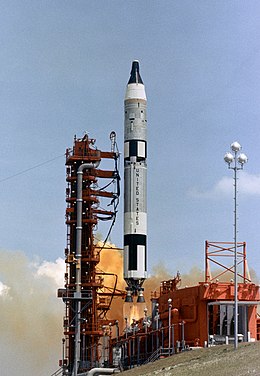
Back Gemini 1 Afrikaans Джемини 1 Bulgarian Gemini 1 Catalan Gemini 1 Czech Gemini 1 Danish Gemini 1 German Gemini 1 Spanish Gemini 1 Estonian جمینای ۱ Persian Gemini 1 Finnish
 Launch of Gemini 1 | |
| Mission type | Flight test |
|---|---|
| Operator | NASA |
| COSPAR ID | 1964-018A |
| SATCAT no. | 00782 |
| Mission duration | Flight test: 4 hours, 50 minutes Launch to rentry: 4 days, 4 hours |
| Distance travelled | 2,789,864 km (1,733,541 mi; 1,506,406 nmi) |
| Orbits completed | 63 |
| Spacecraft properties | |
| Spacecraft | Gemini SC1 |
| Manufacturer | McDonnell |
| Launch mass | 3,187 kg (7,026 lb) 5,170 kg (11,400 lb) with 2nd stage |
| Start of mission | |
| Launch date | April 8, 1964, 16:00:01 UTC (11:00:01 am EST) |
| Rocket | Titan II GLV, s/n 62-12556 |
| Launch site | Cape Kennedy, LC-19 |
| End of mission | |
| Disposal | Uncontrolled reentry |
| Decay date | April 12, 1964, 21:00:00 UTC |
| Landing site | Middle of South Atlantic Ocean |
| Orbital parameters | |
| Reference system | Geocentric |
| Regime | Low Earth orbit |
| Perigee altitude | 155 km (96 mi; 84 nmi) |
| Apogee altitude | 271 km (168 mi; 146 nmi) |
| Inclination | 32.5° |
| Period | 88.76 minutes |
| Epoch | April 10, 1964[1] |
Gemini 1 was the first mission in NASA's Gemini program.[2] An uncrewed test flight of the Gemini spacecraft, its main objectives were to test the structural integrity of the new spacecraft and modified Titan II launch vehicle. It was also the first test of the new tracking and communication systems for the Gemini program and provided training for the ground support crews for the first crewed missions.[3]
Originally scheduled for launch in December 1963, difficulties in the development of both the spacecraft and its booster caused four months of delay. Gemini 1 was launched from Launch Complex 19 at Cape Kennedy (now Canaveral), Florida on April 8, 1964. The spacecraft stayed attached to the second stage of the rocket. The mission lasted for three orbits while test data were taken, but the spacecraft stayed in space for almost 64 orbits until its orbit decayed due to atmospheric drag. The spacecraft was not intended to be recovered, and holes were drilled through its heat shield to ensure it would not survive re-entry.
- ^ McDowell, Jonathan. "SATCAT". Jonathan's Space Pages. Retrieved March 23, 2014.
- ^ "Gemini 1". NASA Space Science Data Coordinated Archive. Retrieved June 28, 2018.
- ^ "Gemini 1". Gunter's Space Page. December 11, 2017. Retrieved October 15, 2012.